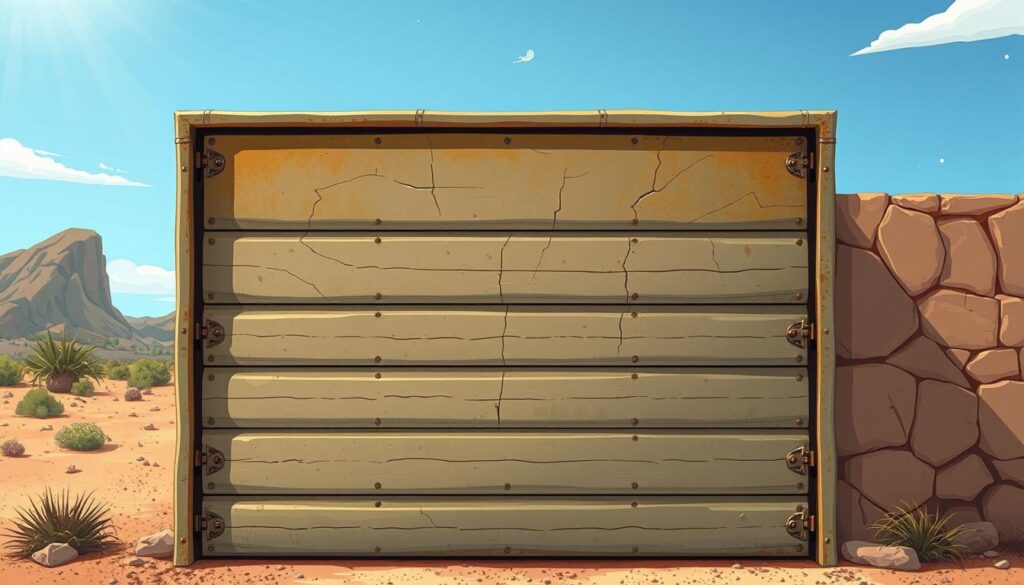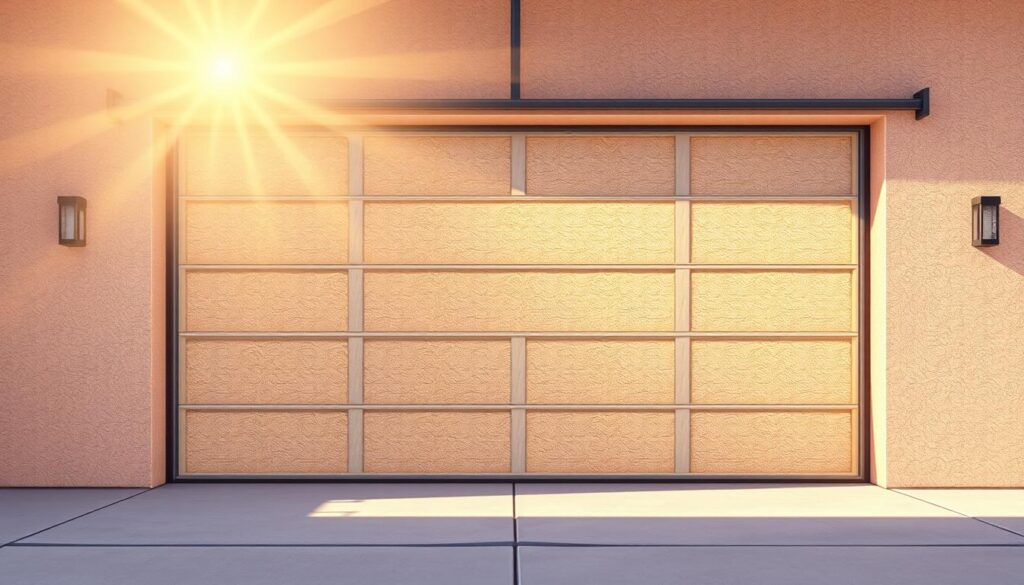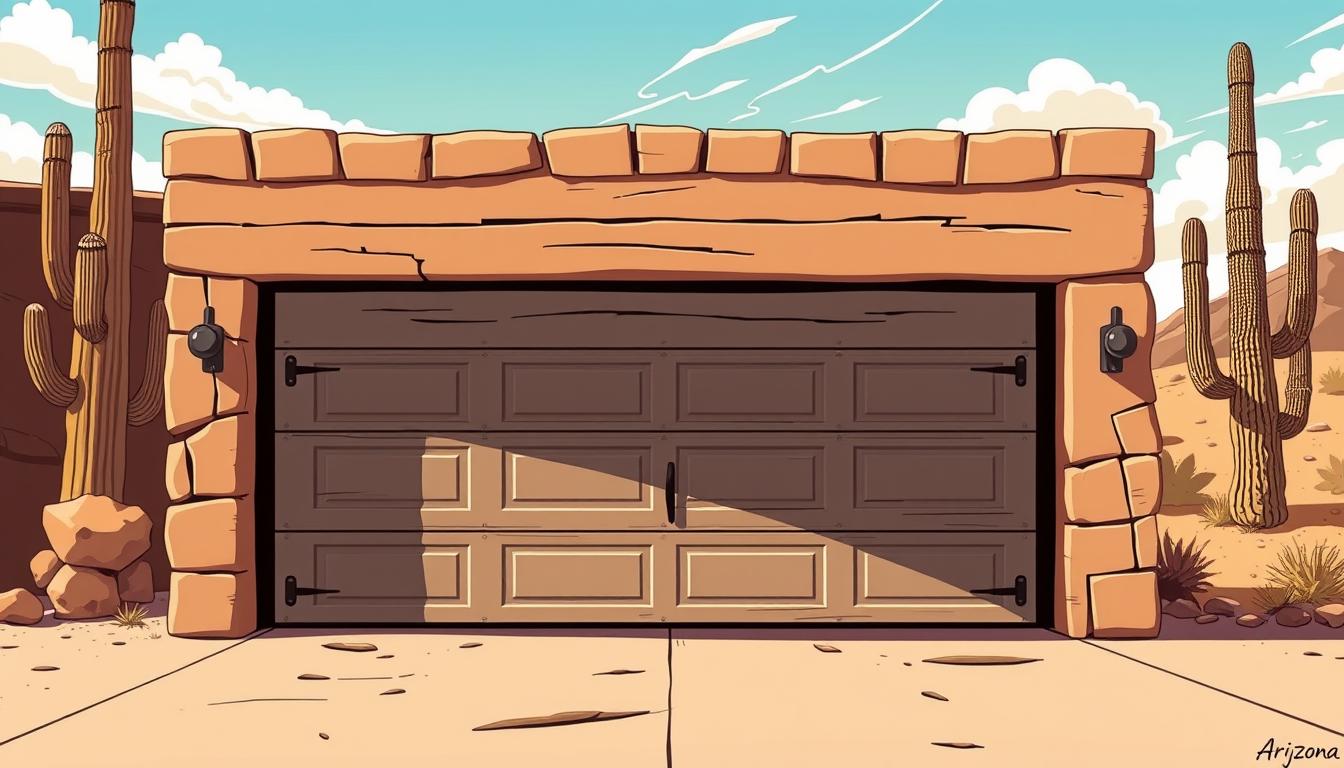Arizona’s weather is known for its intense heat and unpredictable storms. These harsh conditions can significantly impact the functionality and longevity of garage doors. It’s important for homeowners to understand how Arizona’s weather affects their garage doors.
The state’s extreme temperatures can cause garage doors to expand and contract. This can lead to damage over time. Strong winds can also affect the structural integrity of these doors. It’s vital for homeowners in Arizona to ensure their garage doors are durable in harsh conditions.
By understanding these impacts, homeowners can take proactive steps to protect their garage doors. This knowledge helps in selecting the right materials and maintenance strategies for garage doors.
Understanding Extreme Temperatures and Their Effects
Knowing how extreme temperatures affect garage doors is key for Arizona homeowners. The desert climate means garage doors face intense heat during the day and cold at night. This can lead to mechanical problems.
What Constitutes Extreme Temperatures?
Extreme temperatures are the highs and lows that make materials expand and contract. In Arizona, summer temperatures can hit over 105°F, while winter drops below 40°F. These changes can impact the thermal performance of garage doors. It’s important to think about climate control technology when choosing or maintaining a garage door.
How Temperature Fluctuations Occur in Arizona
Arizona’s desert climate sees big changes in temperature from day to night. The sun heats up surfaces during the day, causing garage door materials to expand. At night, the temperature drops, causing them to contract. This cycle can wear down garage door mechanics.
The repeated expansion and contraction can cause the garage door to become misaligned or develop issues with its tracks and hinges. Regular maintenance is key to prevent these problems and keep the door working smoothly.
Ways Heat Affects Garage Door Mechanics
The intense heat in Arizona can damage garage door materials over time. Metal doors can expand, causing them to stick in their tracks or affect the door’s balance. The heat also affects the lubrication of moving parts, making regular checks and maintenance essential.
Using garage doors made from materials that resist extreme temperatures and ensuring proper installation can help reduce the heat’s impact on garage door mechanics.
Common Garage Door Problems in Hot Climates
The extreme heat in Arizona can cause many issues for garage doors. These include material damage and mechanical failures. It’s important for homeowners to know these problems to keep their garage doors in good shape.
Warping and Deterioration of Materials
High temperatures can warp and damage garage door materials. Wooden doors might crack or shrink. Metal doors can expand and contract, leading to misalignment.
Using weatherproof materials and temperature-resistant seals can help. Homeowners should look for garage doors made from materials that last well in harsh conditions.

Misalignment of Tracks and Hinges
The intense heat can make metal garage door parts expand. This can cause tracks and hinges to misalign. This misalignment can make the garage door malfunction.
Regular checks and adjustments can prevent these problems. It’s also key to keep tracks and hinges well-lubricated.
Increased Risk of Rust in Metal Doors
Even though it might seem odd, metal garage doors can rust in hot climates. This is more likely if they’re not coated or maintained well. High temperatures can speed up rust, even with small damages.
Applying a protective coating and checking the door for damage can help. This can prevent rust from forming.
Knowing these common issues helps Arizona homeowners protect their garage doors. They can choose the right materials, do regular maintenance, and fix problems quickly. This ensures their garage doors last long and work well.
Choosing the Right Garage Door for Arizona’s Weather
The heat and sunlight in Arizona are extreme. You need a garage door that’s tough and can handle the weather. Look at the material, insulation, and UV resistance to find the right one.
Best Materials for Hot Climates
In Arizona’s heat, picking the right garage door material is key. Weatherproof materials like vinyl and fiberglass are great. They don’t warp or fade, keeping your door looking good for years.
Steel is also a good choice because it’s strong and can take the heat. But, make sure it has a rust-proof coating. Aluminum is another option, being light and resistant to corrosion.
Insulated vs. Non-Insulated Garage Doors
Insulation is important for keeping your garage at a comfortable temperature. Optimal insulation keeps it cool in summer and warm in winter. This makes your garage more comfortable and saves energy by reducing heating and cooling needs.
| Feature | Insulated Garage Doors | Non-Insulated Garage Doors |
|---|---|---|
| Energy Efficiency | High | Low |
| Durability | High | Moderate |
| Cost | Higher | Lower |
UV Resistance and Durability Factors
Arizona’s sun can damage garage doors, but UV-resistant ones can help. Vinyl and fiberglass doors often have UV stabilizers. This makes them last longer.
Don’t forget about regular maintenance. Keep moving parts lubricated and check for wear. This will help your garage door last longer.
Maintenance Tips for Extreme Heat
The Arizona sun is tough on garage doors. Regular upkeep is key. Extreme heat can damage materials and break mechanical parts, leading to expensive fixes if not fixed fast.

Regular Inspections and Adjustments
Regular checks are vital to catch issues early. Look at the garage door’s alignment. Make sure it moves smoothly without jerks or odd sounds. Adjust the tracks and hinges as needed to avoid wear and tear.
Lubrication of Moving Parts
Lubrication is essential for your garage door’s health. Use a high-temperature lubricant on hinges, rollers, and springs. It cuts down on friction and overheating. This improves the door’s performance and durability in harsh conditions.
Importance of Cleaning Off Dust and Debris
Dust and debris can block garage door tracks and rollers. Regular cleaning with a soft brush or cloth helps. Also, keep temperature-resistant seals clean to maintain the door’s function and efficiency.
Following these maintenance tips can make your garage door last longer. It will work well even in Arizona’s hot weather. Using climate control technology and keeping your garage door in good shape also saves energy at home.
Signs Your Garage Door Needs Immediate Attention
The hot weather in Arizona can harm your garage door. Knowing the warning signs is key for quick fixes. Garage doors are more than just entrances; they’re also part of your home’s look and safety.
Unusual Noises During Operation
Unusual sounds like grinding, scraping, or squeaking mean your garage door needs help. These noises often point to worn-out parts or misalignment. It’s important to check these sounds quickly to avoid more damage.
Noticeable Gaps or Misalignment
Visible gaps or misalignment are another sign. If your garage door doesn’t close right or has gaps, it might be the heat. This can mess with the door’s thermal performance and raise your energy bills.
Slower Opening/Closing Speed
A garage door that moves slowly might have mechanical problems from the heat. The high temperatures can slow it down. Keeping moving parts well-lubricated can help.
To understand these signs better, see the table below:
| Sign | Possible Cause | Recommended Action |
|---|---|---|
| Unusual Noises | Worn-out parts or misalignment | Inspect and replace worn-out parts; realign the door |
| Noticeable Gaps or Misalignment | Material expansion/contraction due to temperature changes | Adjust the door’s alignment; check for damaged parts |
| Slower Operation | Mechanical issues due to extreme heat | Lubricate moving parts; check for worn-out components |
Watching for these signs can help fix problems early. This keeps your garage door working well, even in Arizona’s hot weather.
The Role of Insulation in Temperature Regulation
Arizona’s hot summers and cold winters make insulation key for garage doors. Insulated doors help control temperature, saving on heating and cooling costs.
Insulated garage doors offer many benefits. They keep the garage temperature steady and boost your home’s energy efficiency. Here are some main advantages:
- Reduced heat transfer during extreme temperatures
- Enhanced durability of the garage door due to reduced material stress
- Potential reduction in energy bills due to improved thermal performance
Benefits of Insulated Garage Doors
Insulated garage doors are made to keep your garage cool in summer and warm in winter. They use materials like polyurethane or polystyrene for better insulation.
How Insulation Helps in Energy Efficiency
Insulation stops heat from entering or leaving the garage. This keeps the temperature stable. It also helps the garage door last longer, making it more energy-efficient.

Cost Savings on Heating and Cooling
Insulated garage doors save money on energy bills. They reduce the need for heating or cooling, cutting down on costs. They also lower maintenance costs over time.
In summary, adding insulation to garage doors is smart for Arizona homeowners. It boosts energy efficiency and saves money. Insulated garage doors are a great investment for any home.
Garage Door Safety Features in Extreme Weather
Keeping your garage door safe is key in extreme weather. Arizona’s harsh conditions can affect garage doors. Adding the right safety features is vital to avoid accidents and keep your door working well.
Importance of Proper Weather Stripping
Weather stripping is a must for your garage door’s safety. It seals the door and frame, stopping water and protecting from extreme temperatures. Using weatherproof materials and temperature-resistant seals boosts the door’s performance.
Safety Sensors and Automatic Reversing Mechanisms
Safety sensors and automatic reversing are key. They stop the door if something is in its way, keeping everyone safe. This is super important for homes with pets or kids, as it lowers injury risks.
Benefits of Remote Access Systems
Remote access systems add safety and ease. They let you control your garage door from afar, keeping you safe from harsh weather. This is a big plus during extreme weather.
| Safety Feature | Benefit | Relevance to Extreme Weather |
|---|---|---|
| Proper Weather Stripping | Prevents water ingress and reduces damage from extreme temperatures | High |
| Safety Sensors and Automatic Reversing | Prevents accidents by detecting obstacles and reversing door direction | High |
| Remote Access Systems | Enhances convenience and safety by allowing remote operation | Medium |
Emergency Repairs for Your Garage Door
Emergency repairs for garage doors are sometimes unavoidable, mainly in places like Arizona. The state’s extreme temperatures and weather changes can damage garage doors. This leads to malfunctions that need quick attention.
When to Call a Professional
It’s important to know when to call a professional for garage door issues. If you hear unusual noises, see gaps, or notice slower operation, get help. These signs can mean serious problems that could get worse or be dangerous.
Key indicators that professional assistance is necessary include:
- Unusual noises during operation
- Visible signs of wear or damage on the door or its components
- Misalignment or significant gaps between the door and the floor
Temporary Solutions for Garage Door Malfunctions
While waiting for a pro, you can try some quick fixes. If your garage door is stuck or won’t close, check the tracks and clear the path. But, these fixes aren’t a permanent solution, and Arizona’s harsh climate demands more.
Some garage doors have climate control technology to keep the garage cool. Knowing what your door can do can help.
Contacting Local Repair Services in Arizona
In Arizona, finding a reliable garage door repair service is key. Look for companies with experience in extreme weather. Check reviews, ask for referrals, and verify licenses to find a good service.
Being proactive and knowing when to ask for help keeps your garage door in good shape. This is important in Arizona’s tough climate.
Preparing for a New Garage Door Installation
Getting a new garage door is more than just picking a style. You need to think about how it will handle Arizona’s weather. A good installation means optimal insulation, energy-efficient design, and weatherproof materials. These are key for lasting well and working right.
Factors to Consider Before Purchase
Before you buy a garage door, think about a few things. The material should be tough and handle hot and cold well. Weatherproof materials are great for Arizona because they fight off the sun and rain. Also, an energy-efficient design can save you money on your bills.
Insulation is another big deal. Optimal insulation keeps your garage comfy and cuts down on heating and cooling work. Decide if you want insulated or non-insulated doors based on what you need.
Selecting a Reputable Contractor
Finding the right contractor is as important as picking the door. A good contractor will install it right and fast. Look up local contractors, read what others say, and ask for their past work.
A good contractor knows how to install in Arizona’s weather. They’ll make sure the door is sealed right and lasts long.
Understanding Local Building Codes
Knowing and following local building codes is key. These codes keep everyone safe and buildings standing. A smart contractor will know these codes and help you follow them.
Following local codes means your garage door is installed safely and right. It also avoids legal trouble and makes sure the job is up to standard.
Conclusion: Protecting Your Garage Door Investment
Keeping your garage door in top shape in Arizona means knowing how to handle the heat. Regular upkeep and smart choices can make your garage door last longer in tough weather.
Regular Maintenance Matters
Checking your garage door often and keeping it well-lubricated can prevent problems. Make sure it’s aligned right and fix any wear and tear quickly.
Adapting to the Arizona Climate
Choosing garage doors made for hot weather can help avoid issues. Insulated doors, for instance, keep temperatures steady and save energy. They’re a smart pick.

